
Universidade Fernando Pessoa
Porto, Portugal

Since the Exxon team held that tectonism is not responsible for generation of sequence boundary unconformities1 several papers were published criticizing such a conjecture.2 In fact, several geologists3,4 think that relative sea level changes can be also caused by continental tectonism that are regional to local in scope, and act over time periods of tens of millions to tens of thousands of years (possibly less)5.
“Tectonism of this type”...... wrote Myall6,
“is driven primarily by plate tectonics processes. Extensional and contractional movements accompanying the relative motions of plates cause crustal thinking and thickening and changes in regional thermal regimes, and this leads to regional uplift and subsidence. These stresses and strains are generally primarily at plate margins but, because of the rigidity of plates, they may be transmitted into plate interiors and affect entire continents. By their very nature these mechanisms of sea level change are regional, possibly even continental in extent, but cannot be global, because they are driven by processes occurring within or beneath a single plate or by the interaction between two plates. They affect the elevation of the plate itself, rather than the volume of the ocean basins or the water within them. This category of sea level change is therefore not eustatic. However, they can simulate eustatic effects through the full range of geological episodicities over wide areas, and it is now thought by many researches that tectonic mechanisms were responsible for many of the events used to define the global cycle charts of Haq et al. (1987, 1988). An important additional point is that because the earth is finite, regional plate-tectonic events, such as ridge reordering or adjustments in rotation vectors, may result in simultaneous kinematics changes elsewhere. It is possible therefore for tectonic episodes to be hemispheric or even global in scope. However, such episodes would take a different form (uplift, subsidence, extension, contraction, tilting, translation) within different plates and even within different regions of a given plate. It is possible therefore that simultaneous events of relative sea level change occurring over wide areas but of varying magnitude and in the same or opposite direction could be genetically related”.
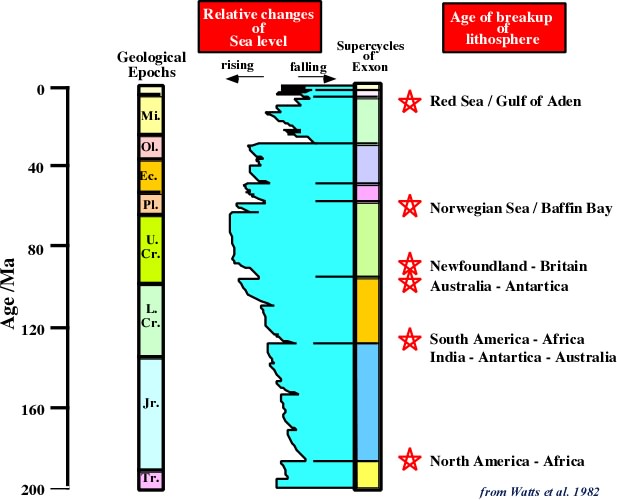
Fig. 31- Break-ups of lithosphere seem to correlate with the major sea level falls of Exxon’s chart.
Fig. 31, taken from Watts7, clearly illustrates that the timing of major rifting events correspond grosso modo with the onset of the major rising relative sea level of the global cycle chart of Vail et al 8. In fact, it is easy to recognize that the rifting between North America and Africa, which took place at the end Triassic, appears interlinked with the initiation of Jurassic sea level rise. In the same way, the rifting between South America and Africa is coeval with the Cretaceous initiation of the sea level rise. The interlinking rifting-sea level rise is also valid when Newfoundland and Britain, Norwegian Sea and Baffin Bay, or Red Sea and Gulf of Aden broke apart.
In spite of the tectonic versus eustasy controversy, particularly in foreland basins, will be discussed in detail in part III of this short course, I would like to remind, since now, what E. Mutti9 wrote on this subject in tectonically active basins:
“Ancient fluvio-deltaic systems”deposited in tectonically active basins are essentially built up intergradational fan-delta and river-delta systems dominated by catastrophic flooding. These systems and their component depositional elements cannot, therefore, be described and interpreted in terms of current sedimentological model based on “normal” fluvial and deltaic processes, facies and geomorphic settings derived from the study of modern environments. Direct and indirect sedimentological and stratigraphic evidence indicates that “normal” sedimentation occurred also in these systems, but its preservation potential appears to be very small with the exception of tidal diffusion in estuarine settings. Facies and facies associations of ancient flooding dominated depositional systems include a very broad spectrum of essentially poorly described and understood sediments that vary from thick bedded and disorganized conglomerates to thin bedded graded mudstones via a great variety of pebbly sand sandstone and sandstone facies. Despite this variability, all these sediments are characteristically composed of graded flood units in both alluvial and marine environments. The greatest preservation potential of individual flood units is found in the final marine depositional zones of each system considered. Ancient flood dominated fluvio-marine systems comprise huge accumulations of conglomerates, sandstone and mudstone facies whose origin and stratigraphic importance have been essentially overlooked in previous literature. These depositional systems can be understood only in terms of tectonically controlled physiographic settings characterized by small and medium sized fluvial systems with high elevation drainage basins and high gradient transfer zones located close to marine basins".
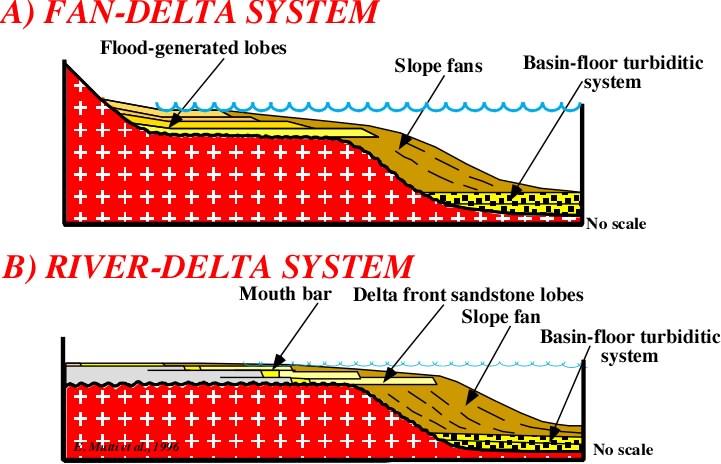
Fig. 32- In Mutti’s fan-delta and river-delta system model the tectonic activity and catastrophic floodings are paramount.
In settings of this type, sediment flux to the sea can dramatically increase when climatic conditions provide sufficient amounts of water to produce catastrophic floods.
- These floods generate mixtures of water and sediment that can enter sea waters with sufficient velocity and sediment concentration to produce hyperpycnal flows and related, shelf-sustained turbiditic currents.
- The resulting depositional settings are thus dominated by flood related facies that can develop in shelfal or deeper marine regions.
- Thick and laterally extensive successions of shelfal sandstone lobes with flood generated hummocky cross-stratification are the fundamental depositional element of both fan-delta and river-delta systems.
- These lobes are essentially similar to deeper-water turbidite sandstone lobes in terms of geometry, facies tracts, and high frequency cyclic stacking patterns.
- Shelfal sandstones lobes probably represent the only possible expression of fluvial-dominated delta-front sandstone facies, since, in the absence of flood generated hyperpycnal flows, river borne sands can only be redistributed in marine environments by waves and tides.
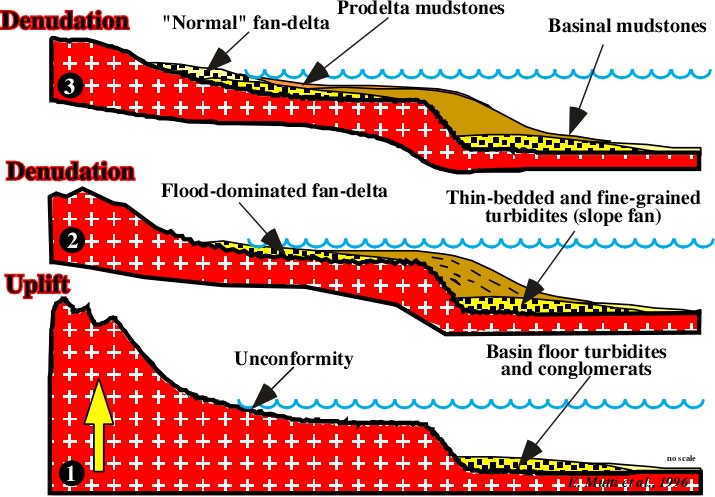
Fig. 33- Uplifting and denudation are responsible of Flood-dominated and normal fan-deltas (Gilbert deltas).
As indicated by their overall stacking patterns, the evolution of ancient flood-dominated fluvio-deltaic systems with time is apparently controlled by the initial uplift of the drainage basin, the rate of denudation, the gradient of each system, and the volume and the sediment concentration of individual floods, the later being a function of the amount of water and sediment made available to the system considered.
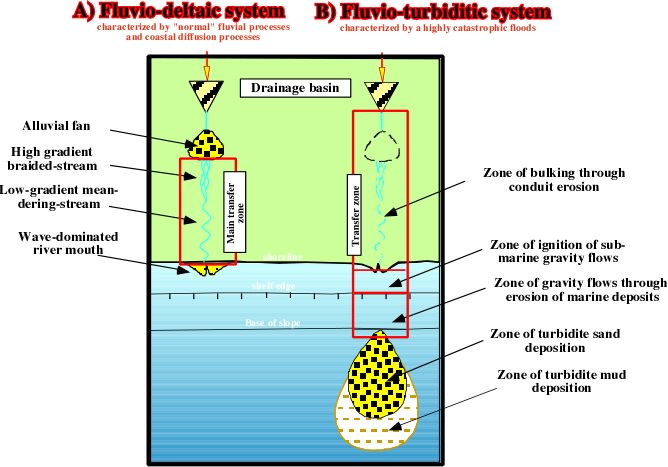
Fig. 34- In turbidite systems associated with highly catastrophic floods, it is important to take into account not only the drainage basin and the transfer zone, but also (i) the zone of ignition of submarine gravity flows, (ii) the zone of gravity flows through erosion of marine deposits (bypass zone) and (iii) the zones of deposition.
"A flood-dominated system of this type comes to an end when the sediment flux to the sea is progressively reduced to “normal” conditions. This occurs when relief and elevation drainage basins and related sediment availability, as well as the gradient of transfer zones have been substantially reduced through progressive denudation and sediment exportation to marine depositional zones. The occurrence of cyclic stacking patterns developed at different hierarchical orders is one of the most striking aspects of flood dominated systems. The most complete record of this cyclicity is preserved in the final depositional zone of each system. These stacking patterns are apparently very similar to those which are though to be characteristic of sequence-stratigraphic models. Despite this apparent similarity, we suggest that the overall vertical evolution of flood dominated systems is primary controlled by a Davisian-type cycles. These cycles produced alternating by an overall forestepping backstepping succession recorded by a basal turbidite system (basin floor fan of sequence stratigraphy) overlain by a flood-dominated fluvio-deltaic system which passes upward and landward into a normal fluvial or fluvio-deltaic system with time. Higher-frequency stacking patterns developed within each of the above stages are essentially produced by forestepping-backstepping episodes of sand deposition which are essentially controlled by cyclic climatic variation. The relationships between Davisian-type and higher-frequency climatic cycles and eustasy-driven cycles of relative sea level variations remain to be explored through careful stratigraphic, sedimentological and structural studies carried out without preconceived ideas. It is likely, however, that the eustatic control on flood-dominated sedimentation patterns of high gradient, tectonically active settings cannot generally compare with the importance of tectonism and related cycles of uplift and denudation”.
VIII- Eustatic and Stratigraphic cycles
Geologists now view earth history as a matter of evolution in which some changes are unidirectional (at least, in net effect), others are are oscillatory or cyclic, and still others are random fluctuations, while the whole is punctuated by smaller or greater catastrophes (1) . Stratigraphy is a typical example of a cyclic geological event. Exxon's geologists explained the cyclicity of the Stratigraphy as a consequence of eustatic changes. They assumed that eustasy was the main parameter controlling the stratigraphy and that during each hierarchical eustatic cycle was deposited a correlable stratigraphic cycle.
However, one must not forget that the time duration of an eustatic cycle is always higher than the sum of sedimentary's deposition time1 (2). In fact, one of the first things we learn in stratigraphy is, for instance, that the Cretaceous system in rocks is the equivalent of the Cretaceous period in time. But this is almost certainly not true. The completeness of the stratigraphic cycles is always lower than 1. The rock record is so episodic in its accumulation and so incomplete in its preservation that there have almost certainly been worldwide gaps during which no sediments were deposited, or eroded.
Four types of stratigraphic cycles (fig. 35) are usually recognized in association with the different orders of eustatic cycles2:
Continental encroachment cycles,
Continental encroachment subcycles,
Sequence cycles , and
Parasequence cycles
Continental encroachments cycles
These cycles are associated with 1st order eustatic cycles. They are characterized by a succession of coastal onlaps against the cratons. They fossilize the unconformity created by the aggregation of Supercontinents. Two continental encroachment cycles have been deposited since the begriming Phanerozoic: the Paleozoic and the Meso-Cenozoic cycles. Both are recognizable on all continents and they are believed to be global.
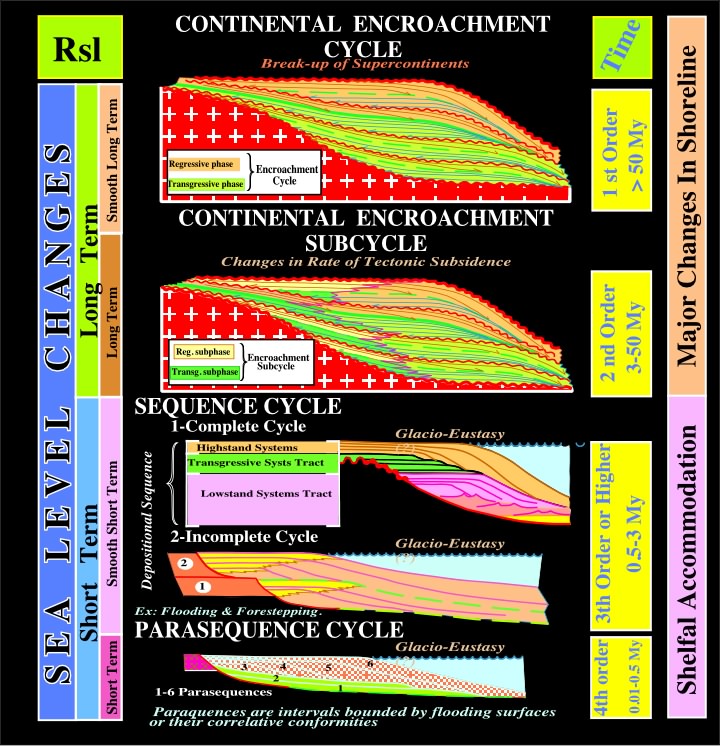
Fig. 36- Hierarchy of the stratigraphic cycles proposed by Duval et al. (1993).
Taking into account that the Latest Proterozoic represents the time of slow encroachment with regression, within Paleozoic cycle:
1) The Cambrian represents the time of extensive encroachment with transgression.
2) The Ordovician represents the eustatic high.
3) The Silurian to Permian represents the time of restriction.
During the Meso-Cenozoic cycle3 :
A) The Triassic represents a time of gradual encroachment of sediments onto the craton. Great thicknesses of non marine sediments were deposited in grabens and bordering marine basins. This general pattern is believed to be caused by a slow relative rise of sea level due to slow long-term rise in eustasy. Non marine rocks were widespread because the sediment supply exceeded the space being created by slow relative rise, resulting in major regression.
B) The Jurassic and Lower Cretaceous represent times of extensive encroachment of sediments on to the continental margins. These sediments are predominantly marine. During this time period the average relative sea level rose more rapidly due to an increase in the rate of rise of long term eustasy. Marine rocks are dominant because the sediment supply did not keep up with the new space being created by more rapid relative rise, resulting in overall transgression.
C) The Lower Turonian is believed to have been the time of the maximum eustatic high.
D) The upper Cretaceous and Cenozoic are characterized by an overall gradual restriction of sediments to the continental margins and basinal areas. This pattern is be lived to be caused by the slow long term fall of the eustasy causing a decreasing relative rise and regression or relative fall and exposure.
Continental encroachment subcycles
These cycles are associated with 2sd order eustatic cycles. They are characterized by unconformities induced by major basinward shifts of coastal onlaps. These basinward shifts interrupt the continuity of continental encroachment associated with breakup of Supercontinents.
Sequence cycles
These cycles are associated with 3rd order eustatic cycles. They are bounded by unconformities induced by changes in water depth, i.e. accommodation in the margins of basins. Sequence cycles are bounded by regional onlap surfaces. These cycles are composed by systems tracts, i.e. by linkage of contemporaneous depositional systems.
Parasequence cycles
These cycles are associated with 4th eustatic cycle or higher. They are bounded by two consecutive flooding surfaces.
With exception of parasequence cycles, all stratigraphic cycles are characterized by the onlap of turbidites and debris flows in deep water environments. In shallower water settings, they are characterized by the onlap of strata deposited in deltaic, coastal or fluvial environments. Sub-aerial and submarine erosional truncations are commonly present below the boundaries of the cycles. In the same way, geometrical relationships of toplap, indicating sediment bypassing, are common under the boundaries of all cycles, particularly in areas of rapid progradation.
In spite of the problem scale and resolution of seismic data discussed previously, I believe that in systemic stratigraphy, particularly when performed on seismic data, the hypothetico-deductive procedure (as proposed by K. Popper) is more appropriate than inductive procedures. In this short course, the discursive approach will be adopted. So, we progress from general to particular rather than the opposite. On other words, the different stratigraphic cycles will be studied in a decreasing hierarchical succession, i.e. from the cycles deposited during 1st order eustatic cycle downward to 3rd or 4th order, as far as possible.
_____________________________________________________
Notes (Tectonism versus Eustasy), (see Bibliography):
1 - see Vail (1991), pp. 619.
2 - see Myall (1997). pp. 225-273.
3 - see Embry, (1993).
4 - see Hiroki, (1994).
5 - see Myall, (1997). pp. 225.
6 - Ibid.
7 - see Watts (1982).
8 - see Vail (1977).
9 - see Mutti (1996).
(Eustatic and stratigraphic cycles)
1 - see Ager (1984).
2 - see Duval (1993).
3 - see Vail (1989).
___________________________________________
Footnotes:
(1) The age of an unconformity (angular or not) is given by the age of the turbiditic deposits associated with it, i.e. it corresponds to the age of minimum hiatus.
(2) Chronostratigraphic units are bodies of rock that represent time units bearing the same formal name. When an epoch (time unit) is designated by the term Early or Late, the corresponding series (chronostratigraphic unit) is identified by the adjective Lower or Upper. However, the Lower Cretaceous series of rocks do not represent the Early Cretaceous time.
to continue press
next
Send E-mails to ccramez@compuserve.com or cramez@ufp.pt with questions or comments about these notes.
Copyright © 2001 CCramez
Last modification:
Março 19, 2006